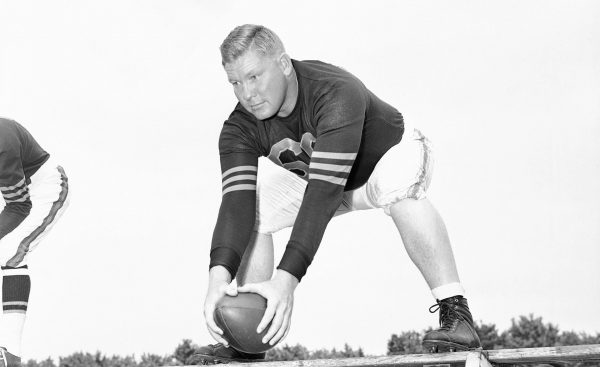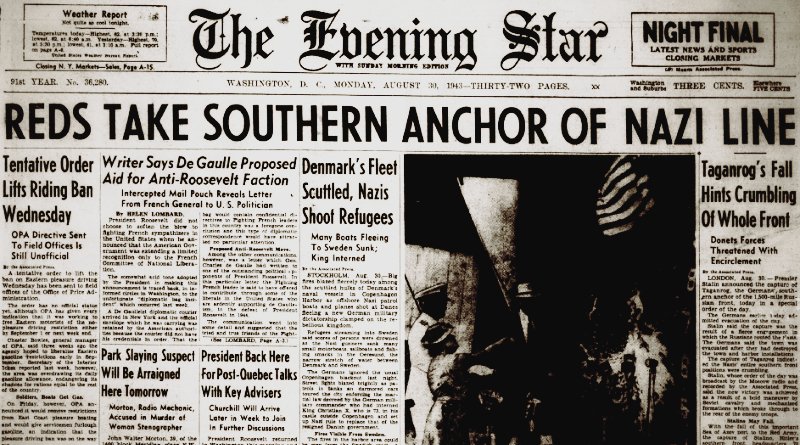World War II Chronicle: August 30, 1943
Click here for TODAY’S NEWSPAPER
George Fielding Eliot column on page eight… Sports on page 12 which carries a column by Grantland Rice. He says the college and pro campaigns should still have plenty of talent this season. He implies the Redskins will be the team to beat this season. Rice mentions “Wee Willie” Wilkin, who will join the Marines next year. Wilkin will play ball at Marine Corps Air Station El Toro. The Packers were hit hard by Cecil Isbell’s retirement after last season, hanging up the cleats after just five years. Isbell and Don Hutson were an absolute terror in 1942: Isbell threw for 2,021 yards — nearly 600 more yards than runner-up Sammy Baugh. Hutson’s 1,211 receiving yards were just short of Ray McLean, Andy Uram, and Jim Benton (second, third, and fourth-place receivers) yardage combined. Rice also mentions the Bears’ Bulldog Turner, who will be putting on an Army Air Force uniform before long.

Since Grantland Rice is previewing the upcoming pro football season let’s take a look at where the NFL’s All-Decade Team is now. Today we will focus on the quarterbacks and halfbacks, and we can get to the other positions over the next couple days.
Quarterbacks: Sammy Baugh, Washington… Sid Luckman, Chicago… Bob Waterfield put in a couple seasons as UCLA’s quarterback and was named first-team quarterback for the 1942 All-Pacific Coast team. He is now in officer candidate school at Fort Benning.
Halfbacks: Tony Canadeo, Green Bay… Last year, rookie Bill Dudley led the NFL in rushing. He is now training to become an Army Air Force pilot… George McAffee joined the Navy after the 1941 season… Charley Trippi is still with the University of Georgia and was named Most Valuable Player in the 1943 Rose Bowl… Steve Van Buren is at LSU. Coach Bernie Moore says Van Buren “probably was the greatest running back in Southeastern Conference history, and I used him as a blocking back until his last year. The folks in Baton Rouge never let me forget that…” Byron “Whizzer” White is a Naval intelligence officer serving in New Caledonia. On this day 80 years ago he was likely working on the intelligence report on the sinking of his friend Lt. John F. Kennedy’s PT-109…
Roving Reporter by Ernie Pyle
SOMEWHERE IN SICILY — If there were only a little more modernism and sanitation in Sicily I think a good many of us would sort of like the place.
Actually most of us feel friendlier toward the Sicilians than we did to the French in North Africa. And in comparison with the Arabs — well, there just isn’t any comparison.
Nobody can deny that north Sicily is beautiful. It is mountainous, and all but the highest mountains are covered with fields and orchards. Many of the hillsides are terraced to prevent erosion. Everything is very old and if it were only clean as well it would be old in a nice, gentle way.
The north coast is a strange contrast to the south. On the south coast the towns are much filthier and the people seem to be of a lower class. Coming from the south to the north there is a freshness about the country and the people. The macadam road that follows the sea all the way from Palermo to Messina is a scenic one. I’ve heard a dozen soldiers say, “If you could only travel this road in peacetime it would be a nice vacation, wouldn’t it?”
The interior roads through the mountains are very few, mostly gravel and quite rough. All through the campaign our troops had to use mules to get their supplies up to them in the mountains and three times during the battle men went without food and water for as long as 60 hours. How they kept going is beyond me but I’ve reached the point where nothing the infantry does startles me any more.
The Third Division had more than 500 mules at the end of the campaign. They brought 50 burros with them from Africa but discovered the burros couldn’t keep up with the infantry so they had to abandon them for the stronger Sicilian mules. Most of the mules were pretty poor and we lost lots of them both by artillery fire and plain old exhaustion.
Toward the end of the campaign the Division got so it hauled mules in 2 1/2-ton trucks right up to the foot of the mountains so they could start their pack journey all fresh.
The American doughboy’s fundamental honesty shows up sometimes in comical ways. All through the campaign the various Army Headquarters were flooded with Sicilians bearing penciled notes written on everything from toilet paper to the backs of envelopes saying, “I owe you for one mule taken for the U.S. Army on Aug. 2. Signed, Private John Smith.”
Actually the appropriating of captured enemy equipment (including mules) for military use is legitimate and no restriction need be made but the doughboys, in their simplicity, never thought of that.
Captured supply dumps are impounded by the Army for reissue later but our soldiers often get in to help themselves before the Army gets there officially. For example, at one time practically every soldier you saw was carrying a packet of German bread — thin, brittle stuff that resembles what we call rye crisp at home.
The soldiers seemed to like it or maybe it was just the novelty of the thing. The Germans, as usual, were well equipped and we are now sporting lots of their doodads. Many of the officers’ outdoor field messes are now served with brand new German folding tables and the diners sit on individual, unpainted German stools.
Also you see quite a few officers sleeping in German steel cots with German mosquito net framework above them. Speaking of mosquitoes, the summer heat and the lack of sanitation have begun to take their toll. Diarrhea is common and there is a run of the same queer fever I had and a good many are coming down with malaria. In fact, the correspondents themselves dropped off like flies with malaria in the last weeks of the campaign. Usually they went to the Army Hospital for a few days until the attack passed and then returned to work.
Our soldiers are very careless about their eating and drinking but you can’t blame them. One of the most touching sights to me is to see a column of sweat-soaked soldiers, hot and tired, march into a village and stop for a rest. In a moment the natives are out by the hundreds carrying water in glass pitchers, in earthen jugs, in pans, in anything filling the men’s empty canteens. It’s dangerous to drink this water but when you’re really thirsty you aren’t too particular.
Most of the time over here I’ve approached native food and drink pretty much like a persnickety tourist in peacetime who avoids all fresh vegetables and is very cagey about drinking water but despite that I came down with the fever. A couple of days after getting back to normal I was hit with the “G.I.’s” or Army diarrhea.
Half of our camp had it at the same time. We all took sulfaguanidine but still mine hung on. Then I moved into the field again with the troops, feeling like death, and getting weaker by the moment. One day we drove into a mountain village where the Americans hadn’t been before and the natives showered ups with grapes, figs, wine, hazelnuts and peaches and I finally said, “Oh, the hell with it,” and started eating everything in sight. And within two days I felt fine again.
Moral: It worked once, but it’s a bad habit and you better not try it.
Evening star. (Washington, D.C.), 30 August 1943. Chronicling America: Historic American Newspapers. Lib. of Congress.
https://chroniclingamerica.loc.gov/lccn/sn83045462/1943-08-30/ed-1/
